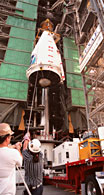
By Rick Obenschain
I was managing the Earth Observing Systems (EOS) platforms project at Goddard Space Flight Center, and I wasn’t looking for a new job. But one day, the new Center Director, Dr. John Klineberg, called me into his office and said “How would you like to be the news GOES project manager?”
I replied, “Well, I don’t think so, John. That sounds like a pretty lousy job.”
He looked a little startled, and I asked him if he’d seen the front page of the New York Times a couple weeks before with the headline, “Hussein Invades Kuwait.” The only other article above the fold that same day was about the Geostationary Operational Environmental Satellite (GOES), and it said something to the effect that the project was “continuing its downslide into oblivion.”
I wasn’t interested in leaving a successful project like EOS — with its six, $1-billion platforms and 17 instruments scheduled to launch on a Titan-4 — for a project that had made the front page news for all the wrong reasons. There wasn’t anything to consider, or so I thought.
“You didn’t think that sounded like a question, did you?” John asked me.
“I thought I heard a little inflection,” I told him. “But I guess I understand the situation now.”
And so I went to work on GOES.
An uphill battle
The project was in horrible shape — about $500 million over budget and five years behind schedule. NASA and the National Oceanic and Atmospheric Administration (NOAA) needed to launch weather satellites to replace the aged, limping satellites doing the job at the time. They had spent $100 million a year on GOES to build hardware that didn’t work so far.
You get in on a program like that and nobody really expects you to succeed. The funny thing is that low expectations can actually give you a little more freedom to work things out. You can do something like I did, for example, by telling the Secretary of Commerce that you need a bit more of your money upfront.
He said to me, “This is the money we have.” And I said, “If we can get the money on the schedule we’ve asked for, we can launch a fully functional satellite in three years. Or with all due respect, Mr. Secretary, you can keep spending $100 million a year, and you’ll get your satellite on the 12th of never.” He came back and told me that if NASA would commit to that launch date, then he would give us the money — and he did.
While he was thinking about it, I took a look at the number of people working on the project. I said to the government team at the time, “Look, from where I sit, it looks as though the contractors build the instruments, and the contractors build the spacecraft. You need to tell me what you’re doing to make progress happen. This has got to be a team effort.”
I listened to what they all had to say. I figured out what we needed to do on our side, what we didn’t need to do, and what we weren’t ready to do yet. I told my leads that we were going to cut our total work force in half — government and contractors — and we went down from around 800 people to 400. That was enough to do the job, and at the same time I essentially created a savings account by doing this. When problems came up, I could stay within my budget because I was only paying for half the people. That’s a lot of cost.
Taking responsibility
Once we had our budget in line, I needed to find a way to get everybody on the same page. One of the things I took a look at was our award-fee contract.
For the last few years, the contractors had typically been awarded 50 to 60 percent of their potential fees. So, I went to my two contractors and said, “Look, you all have been getting mediocre award fees. I have a deal for you. I’m going to let you pick ten milestones for the next six-month period. The only thing I’m going to require is that you have to pick milestones that truly reflect progress. Something that shows we’re moving from point A to point B in delivering this hardware.”
I went on to tell them that if they achieved all ten of their milestones, they would receive 100 percent of their award fee. But if they missed even one, then they got zero, and I expected to hear no complaints, no arguing, no going to my boss, or anything else.

An encapsulated GOES satellite travels up the gantry at Cape Canaveral for attachment to its launch vehicle in May 1999.
Sure enough, they agreed. Because they got to pick their own milestones, they were certain they could achieve all of them and finally get good award fees. They seemed to have no doubt about it.
Well, at the end of the six months, they missed eight of the ten. That didn’t make any of us too happy. The good thing was, though, they didn’t complain to anyone. The other good thing was that they wanted to try again. I said to them, “Look, you help me figure out how to manage this program, and you will be rewarded.”
Getting the right people
During this time, we were having the most problems with our instruments, which were being built by one of our contractors. I knew that I had to assign someone to take charge of this area, and I knew whom I wanted: Marty Davis. Marty was working on another project, but I had seen him in action on the Gamma Ray Observatory (GRO), and I knew he was the person I needed on my team.
I went to my Center Director and I said, “You know, John, I’ve just got to have somebody who can go on site and ramrod these instruments because we’re not getting anywhere with them.”
He nodded, and asked who I wanted. “You can have anybody you want,” he said.
“That’s good,” I said, “because I want Marty Davis.”
He said, “We can’t move Marty. We just put him on another project ten weeks ago.”
I told him why I needed Marty, and why no one else would do. When Marty heard about it, he almost killed me when I wouldn’t budge from that position, and our friendship of 20 years almost disintegrated. But, in the end, the director put Marty on the project.
Marty spent a couple of years, almost resident, with the contractor. In the process, we made instrument development and integration a team effort between the contractors and Goddard. In fact, Marty did such a great leadership job that after we launched the first satellite in the series, and built most of the second, he threw me off the project. Marty continues as the GOES project manager today.
Talk to me
The instrument that gave us the most trouble was the sounder. Marty told me that despite doing the best they could, trying to meet the specifications for the sounder would delay launch. I needed to understand what was really needed by the people who would be using the instrument. Our customer was NOAA. Unfortunately, we had about three levels between the actual user, the National Weather Service, and the people who worked with us at NOAA.
One day I called up Joe Friday at the National Weather Service. I said, “Joe, what time in the morning do you get in?”
He said, “I get in at 6:30 a.m.”
I asked him, “If I’m standing downstairs at the elevator at 6:30 tomorrow morning, can I have the first half-hour of your day?”
He agreed. I got up early and went over to his office building. When he came in and saw me waiting by the elevator, he said, “Things aren’t going too well, are they, Rick?”
I said, “Joe, they’re not. But I’m going to make a deal with you. If you will tell me right now what’s the minimum you can accept on the first spacecraft, we’ll get it off the ground. Eventually, we’re going to build you five spacecraft, and I promise that every one will be better than the last from the instrument standpoint. But I can’t build the sounder the way you want right now. We’re going crazy. I can’t get agreement on the real requirements from NOAA. So, what can you accept?”
We sat down there and negotiated in thirty minutes what the sounder was going to be like on the first GOES. I left the building before the other NOAA people came in, because I couldn’t be seen there talking to the National Weather Service.
I came back and said, “Okay. We’ve got a plan now. We know how to do this.” I told the people at NOAA what we were doing, and they said, “Well, wait a minute. You’re not meeting the spec.”
I said, “I’m meeting your requirements.”
“No, we want you to meet the spec.”
I said, “We’re not going to meet the spec. We’re going to meet the requirement. Where did that requirement come from? Do me a favor, and go back and talk to the people who are going to use this instrument and make sure that isn’t what they’re willing to work with.”
And guess what the National Weather Service told them? They said, “Yeah, Rick’s right. It’s not the specification, but it’s what we need.”
So, with NOAA’s concurrence, we built our sounder and launched their satellite. We were still the same $500 million over budget that we had been when I joined the program 3 1/2 years before, but the important thing was that, against all odds, we delivered what was needed.
Lessons
- Don’t be afraid to take dramatic action to get your project back on course, including fighting to get the right person for each key position on your team.
- Let your contractors participate in selecting their metrics and incentives.
- Seek out the “real” users of your end product and make certain that you understand their needs.
Question
How open are the communication lines between your project team and your end users? What can a project manager do to facilitate candid communication throughout the project lifecycle?
Search by lesson to find more on:
- Budgets








